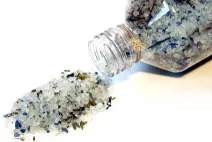A List of Minerals in Foods for Wellness
A list of minerals in foods and different kinds of minerals, all come from earth’s dirt, all are needed for optimal wellness.
Where Do Minerals Come From?
All minerals are metals that come from the earth’s crust. See article “Where Do You Get Your Calcium?” Plants the have selectively chosen particular metals from the soil, which we call “minerals,” for their own health. The plants easily “eat” the metals for their own nutritional needs. Plants are rich in these predigested nutritional metals that humans need. However, humans are unable to digest mineral-rich rocks and dirt. Instead, humans eat the plants (or the animals which have already eaten the plants) and are able to digest the minerals found in the plants.
How Many Different Kinds of Minerals?
A list of minerals in foods may not necessarily include all of the minerals needed for health and wellness. There are 14 considered in the list below. These 14 minerals are divided into two types: Macro minerals and trace minerals. A mineral is considered a macro mineral if your body requires over 100 mg of that particular element. Less than 100 mg and it’s considered a trace element. Both types of minerals are important for health, but the body needs far greater amounts of macro minerals than trace minerals. The best source for both macro and trace minerals is whole foods containing plant digested minerals.
The levels of all of minerals in foods vary depending on the nutrients of the soil where the food is grown. In the case of meats, the levels of minerals in the meat correspond directly to the amount of minerals contained in the plants that the animals have eaten.
A List of Minerals in Foods
Macro Minerals- Calcium - Spinach may possibly be the best single source of calcium. There are at 26 documented food sources of calcium. Some of the 26 sources are green leafy vegetables, blackstrap molasses, summer squash, green beans, oranges, asparagus, rhubarb and cabbage.
- Chloride – Sea salt, table salt, salt substitutes
- Magnesium – Green vegetables, legumes, nuts, seeds and whole grains
- Phosphorus – Milk products— especially raw milk products— red meat, seafood, sunflower seeds, peanuts and whole grains.
- Sodium – Pork products, clams, milk, green beans, butter
- Sulfur – Kale, cabbage, cauliflower, horseradish, cranberries, red meats, fish, eggs, garlic and onions
Trace Minerals
- Iron – Soybeans, lentils, spinach, sesame seeds, pumpkin seeds, red meat and kidney beans
- Zinc – Beef liver, poultry and seafood
- Manganese – Pineapple, brown rice, garbanzo beans, spinach, rye, soybeans, oats, cloves and spelt
- Copper – Beef liver, tree nuts, sesame seeds, soybeans, legumes and whole grains
- Molybdenum – Red meats, whole grains, legumes, sunflower seeds, and dark green leafy vegetables
- Iodine – Fish, seafood, sea vegetables such as kelp
- Chromium – Corn oil, cloves, whole grains, red meat and brewer’s yeast
- Selenium – Whole grains, red meat, poultry, fish
Although the above list of minerals found in food is not a comprehensive list, most of these foods that contain these all-important minerals are classified in the 10 Healthiest Foods. If this is a lot for you to digest (no pun intended!) consider taking a mineral supplement since many of the required minerals for our bodies to operate at peak levels are hard to come by through diet alone - especially if you drink purified water.
I
recommend this high quality results oriented supplement
that contains all of the trace minerals needed for great health.
Go
from List of Minerals in Foods to Best Multi Vitamin
Go
from List of Minerals in Foods to Vitamins and Natural Health
Supplements Home




